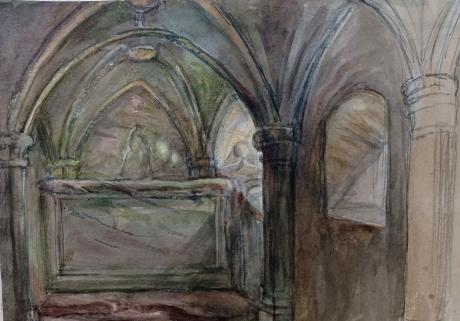inscribed and dated "Warkworth Hermitage 1868" and signed with initials "LWT"
Tom and Laura Taylor and thence by descent
Warkworth Hermitage is a chapel and priest's house built onto and within a cliff-face on the north bank of the River Coquet in Northumberland, England, close to Warkworth Castle and the village of Warkworth.
The hermitage consists of an outer portion built of stone and an inner portion hewn from the sandstone cliff above the river. This inner part comprises a chapel and a smaller chamber, each having an altar. There is an altar-tomb with a female effigy in the chapel.
From the window between the inner chamber and the chapel, and from other details, the date of the work is placed in the latter part of the fourteenth century, the characteristics being late Decorated. The traditional story of the origin of the hermitage, attributing it to one of the Bertrams of Bothal Castle in this county, is told in Bishop Percy's 1771 ballad The Hermit of Warkworth. The ballad is fiction as the chapel was built as a chantry and occupied by a series of clergy from 1489 to 1536; since that time it has remained as it is today.
The carving in the window is a nativity scene; the female is Mary with the newborn child at her breast. The item at her feet is the head of a bull, and the figure at her shoulder is an angel.
Warkworth Hermitage is in the care of English Heritage, who provide its only public access, a ferry boat from the riverside path below the castle. The ferry point is about 1⁄2 mile (0.80 km) upstream from the castle.The hermitage, which English Heritage manages together with the castle, is open to the public during the summer season.
Besides Bishop Percy's ballad mentioned above, the hermitage is the subject of Letitia Elizabeth Landon's poetical illustration Warkworth Hermitage to an engraving of a painting by Thomas Allom, published in Fisher's Drawing Room Scrap Book, 1836.
Laura Wilson Barker (6 March 1819 – 22 May 1905), was a composer, performer and artist, sometimes also referred to as Laura Barker, Laura W Taylor or "Mrs Tom Taylor".
She was born in Thirkleby, North Yorkshire, third daughter of a clergyman, the Rev. Thomas Barker. She studied privately with Cipriani Potter and became an accomplished pianist and violinist. As a young girl Barker performed with both Louis Spohr and Paganini. She began composing in the mid-1830s - her Seven Romances for voice and guitar were published in 1837. From around 1843 until 1855 she taught music at York School for the Blind. During this period some of her compositions - including a symphony in manuscript, on 19 April 1845 - were performed at York Choral Society concerts.
On 19 June 1855 she married the English dramatist, critic, biographer, public servant, and editor of Punch magazine Tom Taylor. Barker contributed music to at least one of her husband's plays, an overture and entr'acte to Joan of Arc (1871), and provided harmonisations as an appendix to his translation of Ballads and Songs of Brittany (1865).
Her other works include the cantata Enone (1850), the violin sonata A Country Walk (1860), theatre music for As You Like It, (April 1880), Songs of Youth (1884), string quartets, madrigals and solo songs. Her choral setting of Keats's A Prophecy, composed in 1850, was performed for the first time 49 years later at the Hovingham Festival in 1899. The composer was present.
Several of Barker's paintings hang at Smallhythe Place in Kent, Ellen Terry's house.
Barker lived with her husband and family at 84 Lavender Sweep, Battersea. There were two children: the artist John Wycliffe Taylor (1859–1925), and Laura Lucy Arnold Taylor (1863–1940). The Sunday musical soirees at the house attracted many well-known attendees, including Lewis Carroll, Charles Dickens, Henry Irving, Charles Reade, Alfred Tennyson, Ellen Terry and William Makepeace Thackeray.
Tom Taylor died suddenly at his home in 1880 at the age of 62. After his death, his widow retired to Porch House, Coleshill in Buckinghamshire, where she died on 22 May 1905, aged 86.



